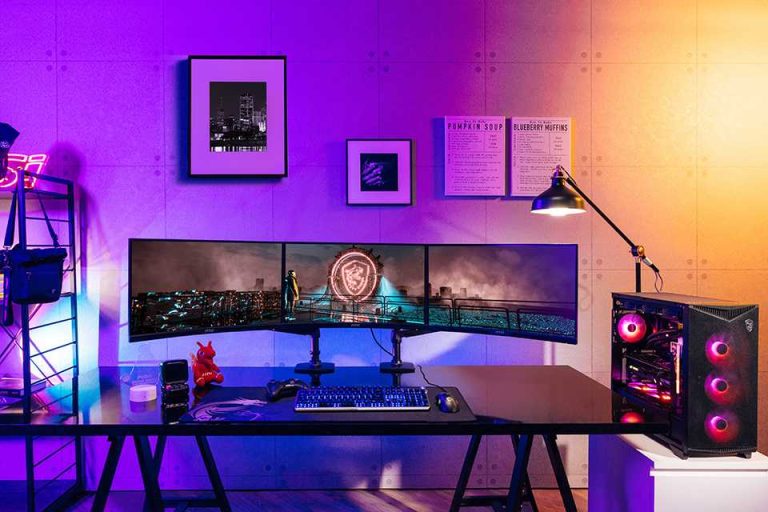To connect your wireless keyboard to your office monitor, start by ensuring your keyboard is charged and in pairing mode. Then, activate Bluetooth on your computer and select the keyboard from the available devices list. If your monitor has Bluetooth or a compatible USB receiver, connect it accordingly. This straightforward process allows you to enjoy a clutter-free workspace and seamless control of your computer.
Connecting a wireless keyboard to your office monitor is quick and simple when you understand the basic steps. First, identify whether your monitor supports Bluetooth or has a USB receiver, then pair your keyboard via Bluetooth settings or connect the receiver. These easy steps help you create a neat, ergonomic setup that keeps your desk tidy and improves your workflow.
When setting up a wireless keyboard with your office monitor, the key is understanding the connection options available. Most wireless keyboards connect via Bluetooth or through a dedicated USB receiver. If your monitor includes Bluetooth capabilities, pairing is a matter of enabling Bluetooth on both devices and selecting the keyboard from the device list. Alternatively, if your keyboard uses a USB receiver, plug it into your computer, and the connection is automatically established. Ensuring your devices are compatible and properly powered will make the process smooth, letting you enjoy the convenience of wireless control at your workspace with minimal effort.
How to Connect Wireless Keyboard and Office Monitor
Setting up a wireless keyboard with your office monitor is a simple process that can enhance your workspace. It allows you to work comfortably without wires cluttering your desk. In this guide, we will go through each step in detail to help you connect your wireless keyboard to your office monitor successfully.
Understanding the Types of Wireless Keyboards and Monitors
Before beginning, it is important to understand the types of wireless keyboards and monitors available. Wireless keyboards often connect via Bluetooth or through a wireless USB receiver. Monitors may have built-in wireless capabilities or need additional devices for wireless connection.
Bluetooth Wireless Keyboards
Most modern wireless keyboards connect via Bluetooth, a technology that allows devices to communicate over short distances without cables. Ensure your office monitor or computer supports Bluetooth functionality.
Wireless USB Receiver-Based Keyboards
Some wireless keyboards use a small USB receiver, often called a **dongle**. This receiver plugs into your computer or monitor and communicates wirelessly with the keyboard. Ensure the receiver is compatible with your device.
Checking Your Office Monitor’s Compatibility
Not all monitors come with built-in wireless features. Verify if your monitor supports wireless inputs or if you need an external device. Many modern monitors connect to computers via HDMI or DisplayPort but lack wireless capabilities.
Built-in Wireless Capabilities
If your monitor supports Wi-Fi or Bluetooth, you may be able to connect your keyboard directly. Consult the user manual for specific instructions on wireless connections.
External Wireless Adapters for Monitors
If your monitor does not have wireless features, you can use external adapters like wireless HDMI transmitters or Wi-Fi-enabled devices that project your computer screen wirelessly. These are typically used to mirror your desktop to the monitor.
Preparing Your Devices for Connection
Before connecting, gather all necessary equipment and check compatibility. Make sure your keyboard is fully charged or has fresh batteries. Turn on your monitor and computer or device.
Updating Device Drivers and Firmware
Ensure your Bluetooth drivers and firmware for your devices are updated. This can improve connectivity and prevent issues during setup. Visit the manufacturer’s website for the latest updates.
Enabling Bluetooth on Your Computer or Device
Access your device’s Bluetooth settings on your computer or laptop. Turn Bluetooth on and make sure your device is discoverable. This step is crucial for pairing your wireless keyboard.
Connecting Your Wireless Keyboard via Bluetooth
Follow these steps for a successful Bluetooth connection:
- Activate pairing mode on your wireless keyboard. Usually, this involves pressing and holding a Bluetooth or pairing button until a light blinks.
- Open Bluetooth settings on your computer or monitor. Select ‘Add device’ or ‘Pair new device.’
- From the list of available devices, choose your keyboard. Confirm any prompts that appear.
- Wait for the connection to establish. Once connected, test the keyboard to ensure it works properly.
Troubleshooting Bluetooth Connection Issues
If your keyboard does not connect, try removing and re-adding the device. Restart your computer or device and ensure your keyboard is in pairing mode. Check batteries or charge level if the connection persists.
Connecting Using Wireless USB Receiver
If your keyboard uses a wireless USB receiver, follow these steps:
- Plug the receiver into an available USB port on your monitor or computer.
- Turn on the wireless keyboard. It should automatically connect once powered on.
- Allow a few seconds for the system to recognize the device.
- Test the keyboard to confirm it responds correctly.
Ensuring Proper USB Receiver Functionality
Some receivers require software installation or drivers. Check the manufacturer’s instructions and install any necessary software. Keep the receiver close to the keyboard to prevent signal loss.
Connecting Your Office Monitor for Seamless Use
If your goal is to use a wireless keyboard with a monitor that lacks Bluetooth, consider the following options:
Using External Wireless Keyboards with Monitors
Connect the wireless keyboard to a computer connected to your monitor. This setup allows you to use the keyboard wirelessly while viewing content on your monitor.
Wireless Screen Mirroring Devices
Devices like wireless HDMI transmitters can mirror your computer’s screen to your monitor wirelessly. Pair your keyboard with the computer, and use the external device for a cable-free setup.
Optimizing Wireless Connection Performance
To ensure a reliable connection, keep your devices within close range. Avoid interference from other wireless gadgets. Use a clear line of sight when possible to prevent signal disruptions.
Minimizing Interference
Microwaves, cordless phones, and other electronics can interfere with wireless signals. Position your devices away from such sources for better connectivity.
Using Signal Boosters
If you experience weak signals, consider using Bluetooth range extenders or USB extension cables for the receiver. This can improve range and stability.
Additional Tips for a Smooth Setup
- Maintain firmware and driver updates for all devices.
- Keep batteries fresh to prevent disconnections or lag.
- Place your devices in open spaces to avoid signal obstruction.
- Consult user manuals for specific pairing instructions.
Related Topics to Enhance Your Setup
Using Wireless Mouse and Keyboard Together
Pairing both devices via Bluetooth or USB receiver helps create a cordless workspace. Ensure your devices are compatible and configured correctly.
Choosing the Right Wireless Keyboard for Office Use
Look for ergonomics, battery life, and compatibility features. A keyboard with a sturdy build and reliable connection improves overall productivity.
Maintaining Wireless Devices
Regularly check batteries, update firmware, and clean the devices. Proper maintenance prolongs their lifespan and ensures consistent performance.
How to Set Up a Wireless Keyboard and Mouse – Tech Tips from Best Buy
Frequently Asked Questions
What steps should I follow to pair my wireless keyboard with my office monitor?
Start by turning on your wireless keyboard and ensure it is in pairing mode. Then, access your computer’s Bluetooth settings and select the keyboard from the list of available devices. Confirm the pairing process as prompted, and once connected, test the keyboard to ensure it responds correctly with your monitor or computer.
How can I troubleshoot connectivity issues between my wireless keyboard and monitor?
Check that the keyboard has fresh batteries and is within the optimal range of your computer or Bluetooth receiver. Restart both devices and make sure Bluetooth is enabled. If problems persist, remove and re-pair the device or try connecting through a different port or Bluetooth receiver. Additionally, update your device drivers if necessary.
Is it possible to connect a wireless keyboard directly to a monitor without a computer?
Most office monitors do not support direct Bluetooth connections for wireless keyboards. Usually, these monitors are designed primarily for display input from computers. To connect a wireless keyboard directly, you generally need a computer or a device with Bluetooth capabilities. If your monitor has a built-in Bluetooth receiver, check its specifications to see if it supports peripheral devices.
What accessories might I need to connect my wireless keyboard to my office monitor effectively?
Ensure your monitor has Bluetooth or a compatible wireless receiver. If it doesn’t, you can use a Bluetooth dongle to add wireless connectivity to your setup. Additionally, keep spare batteries or a rechargeable power source for your keyboard to prevent interruptions while working.
Are there specific settings I need to adjust on my monitor or computer to improve the connection stability?
Make sure Bluetooth is enabled on your computer and that the monitor’s Bluetooth settings are correctly configured. Keep the Bluetooth device close to the receiver to minimize interference. Avoid having many wireless devices operating nearby to reduce signal congestion. Adjust the power management settings to prevent Bluetooth from turning off to save energy.
Final Thoughts
To connect a wireless keyboard and office monitor, start by turning on Bluetooth on your computer. Pair the wireless keyboard by selecting it from the available devices. For the monitor, connect via HDMI or DisplayPort as usual. Confirm the connection and set the monitor as your display.
In conclusion, knowing how to connect wireless keyboard and office monitor helps you set up your workspace efficiently. Following these simple steps ensures a seamless connection, making your daily tasks easier.

I follow the latest trends in smart devices, portable monitors, and gaming accessories. My goal is to provide real-world insights that help readers make smarter tech decisions.





